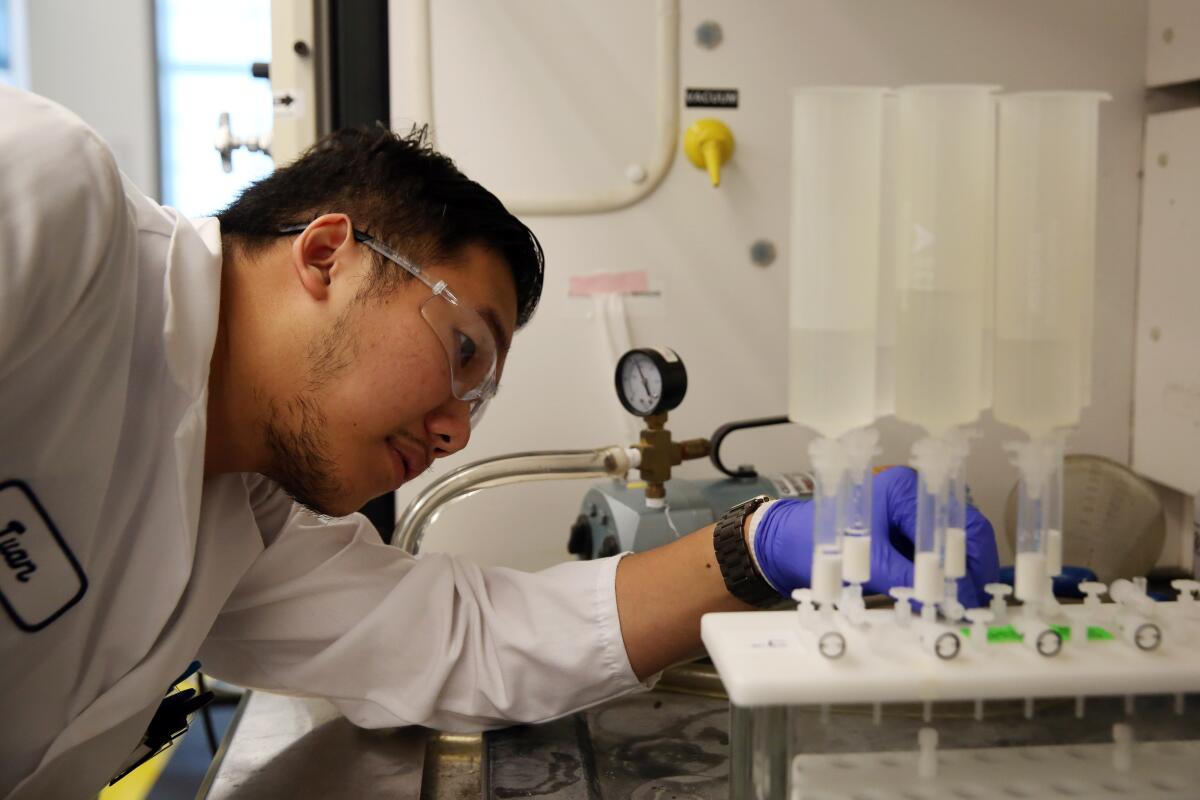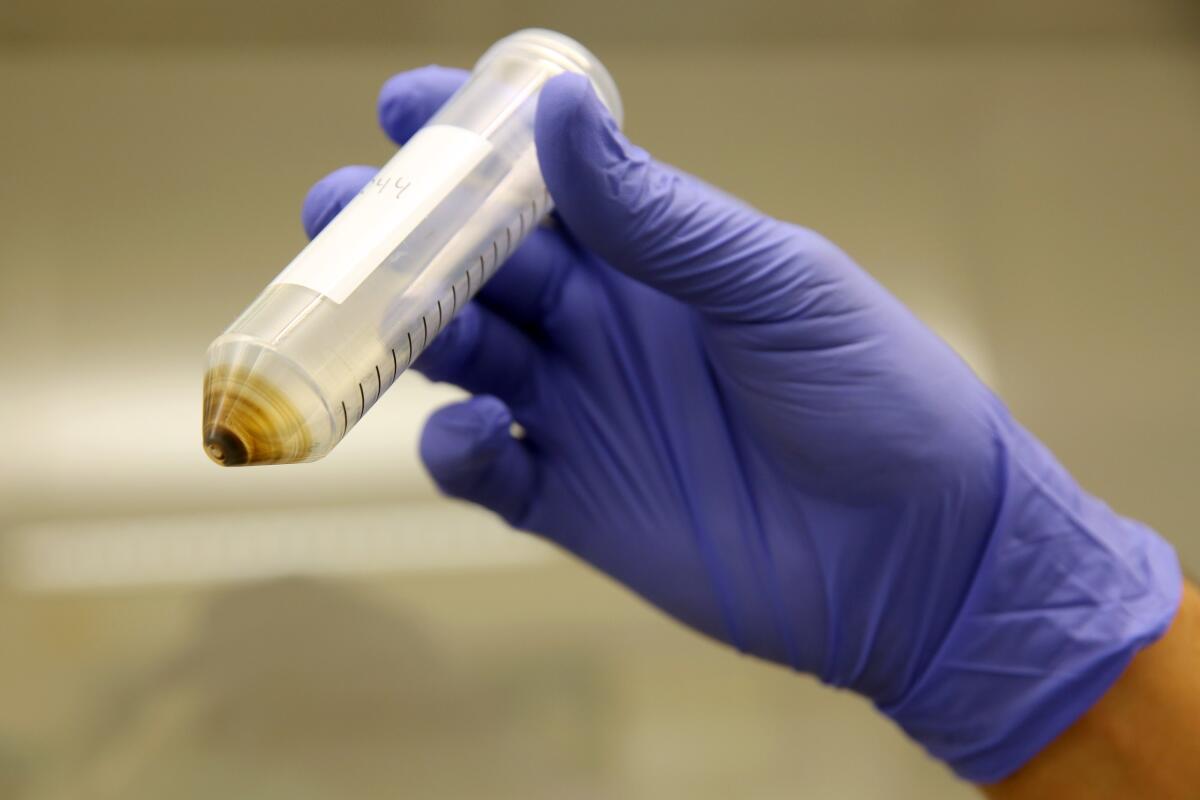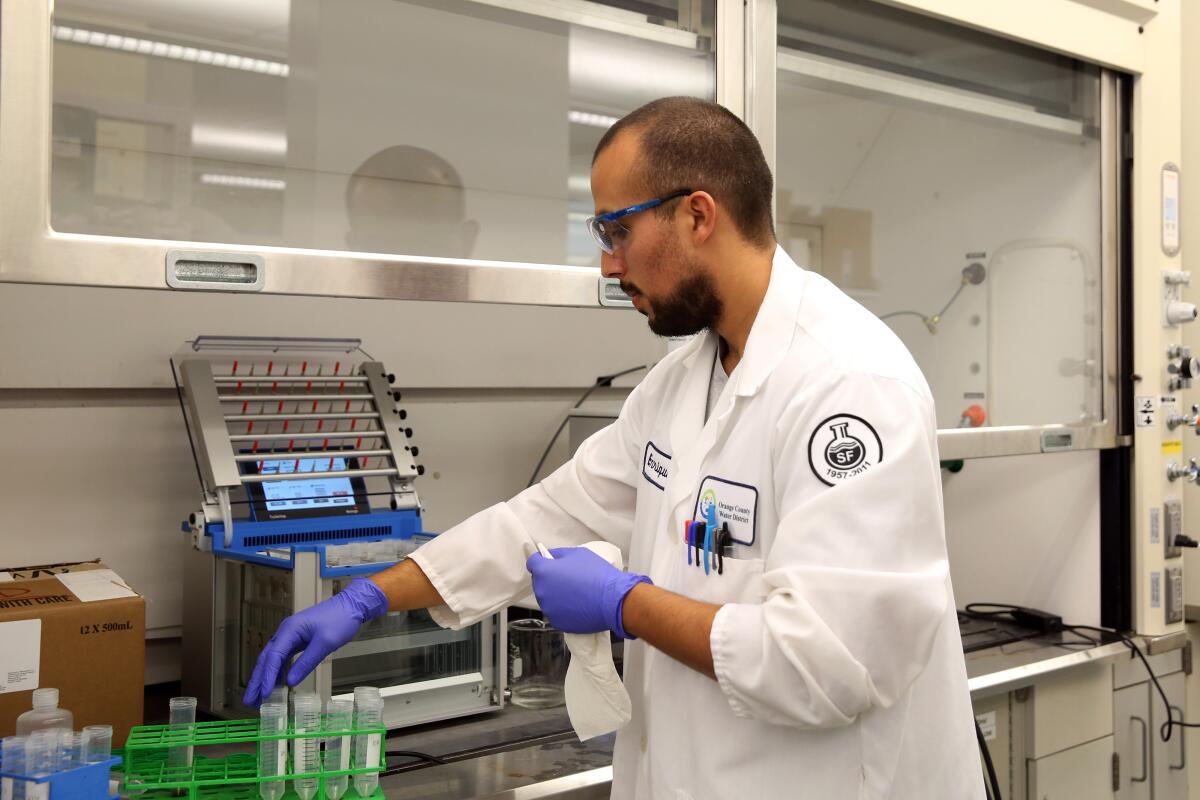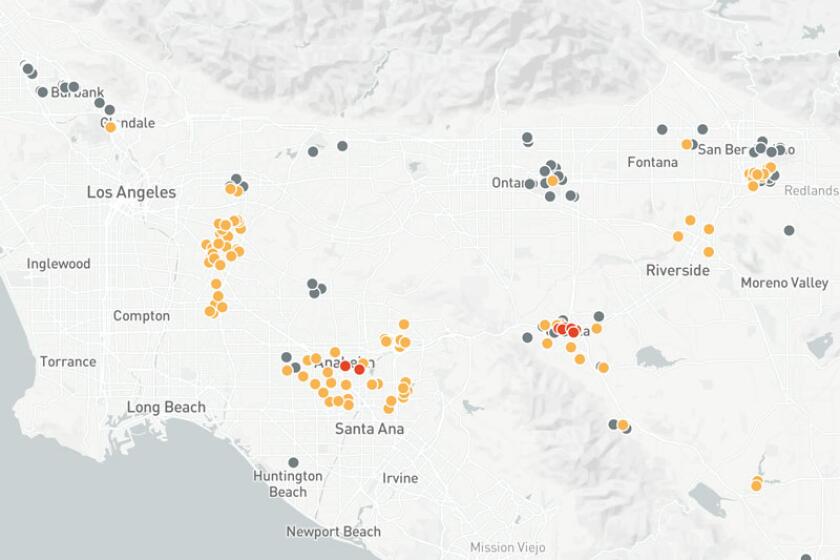California finds widespread water contamination of ‘forever chemicals’

- Share via
WASHINGTON — Nearly 300 drinking water wells and other water sources in California have traces of toxic chemicals linked to cancer, new state testing has found.
Testing conducted this year of more than 600 wells across the state revealed pockets of contamination, where chemicals widely used for decades in manufacturing and household goods have seeped into the public’s water supply. An analysis by the Los Angeles Times found that within this class of chemicals, called perfluoroalkyl and polyfluoroalkyl substances, the two most common compounds were detected in 86 water systems that serve up to 9 million Californians.
State officials released the water quality results on Monday, the first step in what’s likely to be a years-long effort to track the scale of the contamination and pinpoint its sources. Only a small fraction of California’s thousands of drinking water wells were tested in this initial study. Officials said they planned to examine many more, but have not committed to future statewide testing.
The results offered the clearest picture yet of California’s exposure to a public health crisis that is playing out nationally.
“This has the potential of being an enormously costly issue both on the health side as well as on the mitigation and regulatory side,” said Kurt Schwabe, an environmental policy professor at UC Riverside. “It’s going to be one of the defining issues in California, environmentally, for decades.”
About half of the wells sampled did not have the chemicals at detectable levels — a result that state officials said was a hopeful sign the contaminants may not have spread as widely as they have in other states. Yet testing found contaminated drinking water in communities across California, from densely-populated cities with large and complex water systems to mobile home parks that depend on a single private well.
Clusters of contaminated wells were found in Southern California, in Los Angeles, Orange, Riverside and San Bernardino counties. The city of Los Angeles did not detect the chemicals in its water, but neighboring Glendale did.
In some cases, the testing had an immediate effect — the city of Anaheim has shut down three of its drinking water wells so far this year in response to elevated levels of the chemicals.
Exposure to the chemicals, commonly known as PFAS, has been traced to kidney and testicular cancer, as well as high cholesterol and thyroid disease. Mothers and young children are thought to be the most vulnerable to the chemicals, which can affect reproductive and developmental health.

Scientists have called them “forever chemicals” because they persist indefinitely and accumulate in the human body.
The chemicals were developed in the 1940s and used in countless household products, from Teflon cookware and Scotchgard to waterproof clothing and food packaging. They were also a key ingredient in firefighting foam used on military bases and, as a result, have become a major source of groundwater pollution.
A Times analysis found that California has 21 contaminated bases, more than any other state, including six where the chemicals have leached into off-base drinking water supplies.
There is no agreed-upon safe level of PFAS. The Environmental Protection Agency has classified the chemicals as an “emerging contaminant” and has delayed setting a national standard for limiting the levels in drinking water. In 2016, the agency issued a nonbinding health advisory for two of the most common types, PFOS and PFOA, recommending that water utilities notify the public if levels of the chemicals reached a combined 70 parts per trillion.

California health officials are developing their own safety standards for the contaminants.
A state law that takes effect in January will require utilities to inform customers if PFAS are found at any level. It will also force water systems to either shut down wells that test over the federal health advisory level or notify their customers of the contamination — steps that, at present, are only voluntary.
For the first round of testing, California’s State Water Resources Control Board focused on hundreds of wells located within one or two miles of commercial airports, municipal landfills, and water supplies already known to have elevated levels of the chemicals. Each of these wells was tested for about a dozen different compounds within the broader PFAS family, which includes thousands of unique chemicals.
Officials plan to widen their search in the coming months to include drinking water systems near military bases, manufacturing hubs and wastewater treatment plants.
The Los Angeles Times reviewed hundreds of pages of Pentagon documents and found California has more bases contaminated with the chemicals, known as PFAS, than any other state — at least 21 that exceed federal health guidelines.
California has about 3,000 water providers, most of which have not been ordered to test for PFAS. Those that have been forced to confront the problem have looked for solutions based on what they can afford and whether they have other sources of clean water readily available.
An example of this can be found in the cities of Oroville and Chico. Both have detected PFAS in their drinking water wells, but because Oroville gets the majority of its water from Lake Oroville, in the foothills of the Sierra Nevada, local water suppliers there can reduce their reliance on groundwater without feeling pinched. Chico, on the other hand, is dependent on groundwater wells.
“Every water system is different, and that changes the options that you have,” said Loni Lind, water quality manager for California Water Service, which supplies both towns.
In interviews with The Times, water district managers emphasized that having contaminated groundwater wells does not necessarily mean that residents are being exposed to dangerous levels of PFAS. Some utilities have treated the water to remove most of the chemicals, while others have started blending contaminated water with other sources to lower their concentration. Still others have closed wells or put them on emergency-use-only status.
In Orange County, where testing ordered by the state found PFAS chemicals in 10 different water systems, four groundwater wells with elevated levels of the chemicals have been shut down.
Jason Dadakis, Orange County Water District’s executive director of water quality, said that based on water testing, the district concluded that the chemicals were coming from wastewater treatment plants in Riverside and San Bernardino. Those facilities discharge water into the Santa Ana River, he said, which feeds the county’s groundwater basin.

Sewage treatment plants aren’t designed to remove a compound like PFAS, Dadakis said. “It just passes through their system.”
If the chemicals spread and the district is forced to treat the water, Orange County residents could see their water bills rise by as much as 15%, Dadakis said.
Local water suppliers in other parts of the state said they had no idea where the chemicals could be coming from, but they expected answering that question would take years of investigation.
“It’s really difficult to say what’s happening and where it’s being generated,” said Tom Moody, who oversees the city of Corona’s water system, where eight wells tested above the EPA’s health advisory level. Rather than close them all down, the city now sends water from these wells through an existing treatment plant.
“In my generation, we probably absorbed this chemical in everything from tennis shoes to popcorn and pizza and all that stuff,” Moody said. “Now everybody is trying to point the finger at everybody else.”
More to Read
Get the L.A. Times Politics newsletter
Deeply reported insights into legislation, politics and policy from Sacramento, Washington and beyond. In your inbox three times per week.
You may occasionally receive promotional content from the Los Angeles Times.














